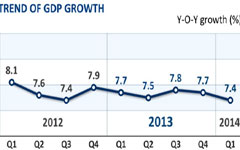China's 7.4-percent economic growth in the first quarter is reassuring not only because it beat market expectations by a shade. More importantly, it signalled desirable progress in the transformation of the world's second-largest economy away from unbalanced and unsustainable growth.
Most observers believed that China would report its slowest growth in five years as a result of unanticipated negative trade growth and slower investment so far this year.
Yet, official statistics put the country's latest quarterly expansion the same as that in the third quarter of 2012, a 0.1 percentage point higher than the median forecast of 7.3 percent.
 |
 |
 |
That Chinese growth is holding up better than expected should at least soothe any anxiety about the need for a new stimulus package to avoid an abrupt slowdown.
And those taking a close look at the latest statistics will even find encouraging signs that the country's economic restructuring is making gradual but promising progress.
While slower investment growth has dragged down the country's overall economic expansion, the improved structure of fixed asset investment has helped lay a solid foundation for more sustainable growth in the future. For instance, the slower growth in property investment will help cool the dangerously overheated housing market.
Besides, faster investment growth in central and western China has further narrowed the development gap between regions. And a 19.6-percent investment growth has made the labor-intensive service sector bigger than the energy-consuming industrial sector which saw only a 14.7-percent investment growth in the first quarter.
Even better news for Chinese policymakers, who are trying hard to guide the impetus for economic growth toward domestic consumption instead of trade and investment, is the fast growth in incomes.
The average disposable income has jumped to 5,562 yuan ($897) in the first quarter, up 11.1 percent over the same period last year, according to a survey by the National Bureau of Statistics.
As inflation stood at 2.3 percent, the money in the pockets of Chinese consumers has obviously grown more than the overall economy so far this year.
This is a desirable trend that Chinese policymakers should do their best to sustain because the country's success in boosting domestic consumption hinges on people's will and power to purchase.
